DCount function in Excel - How to use the DCount function and examples using the DCount function
You have a large list of students who want to get a high total score, but don't want to spend a lot of time. In this article, introduce to you the DCount Function in Excel. Help you use the DCount function and include examples from which you can address your request.
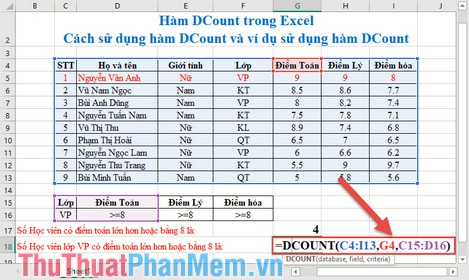 ;
;
Describe the DCount function
The Dcount function counts the number of values (numeric data) of field or column names in a data range with the specified conditions described in the condition area.
DCount function syntax
DCOUNT (database, field, criteria)
Inside:
- Database: Range of cells or container of data to be counted, including the header row in the data area, is a required parameter.
- Field: The field or column name is used to check counting conditions, there are 2 ways to enter data fields:
+ Method 1: Enter the field name of the data column directly, paying attention to the right column name in quotation marks.
+ Method 2: Enter the corresponding ordinal number of that column from the left.
- Criteria: The condition data area used to count quantities, which is a mandatory parameter.
Note Dcount
- The condition area (criteria criteria) must contain the field name.
- Conditional data area should not be placed below the list because if the list below is not empty you cannot add information.
- Make sure the condition area does not coincide with the main data range.
Example of using the DCount function
Give a table of results of students taking the entrance exam. Request:
- Count the total number of office class students participating in the exam
- Count the total number of students with math scores greater than or equal to 8
- Count the total number of office class students with a math score greater than or equal to 8 (counting with multiple conditions containing non-numeric data)
- Count the total number of students in the office class with math scores, chemistry points, and physics scores equal to or greater than 8.
Tutorial:
1. Count the total number of office class students participating in the exam:
Counting the total number of office class students participating in the test => condition area Class = VP. In the cell to count enter the formula: = DCOUNT (C4: I13, F4, C15: C16)
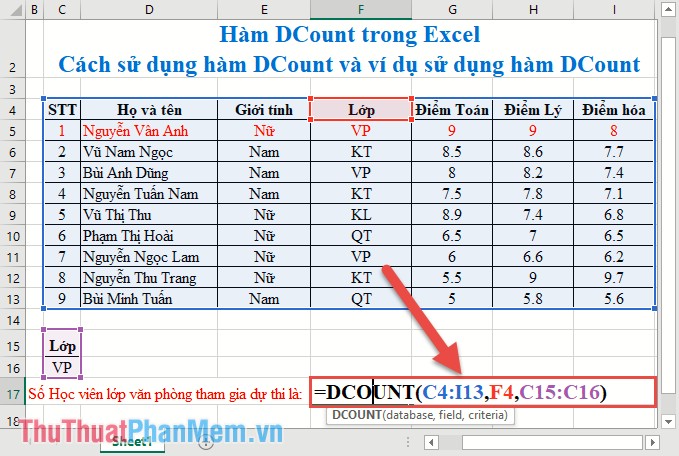
Pressing Enter results:
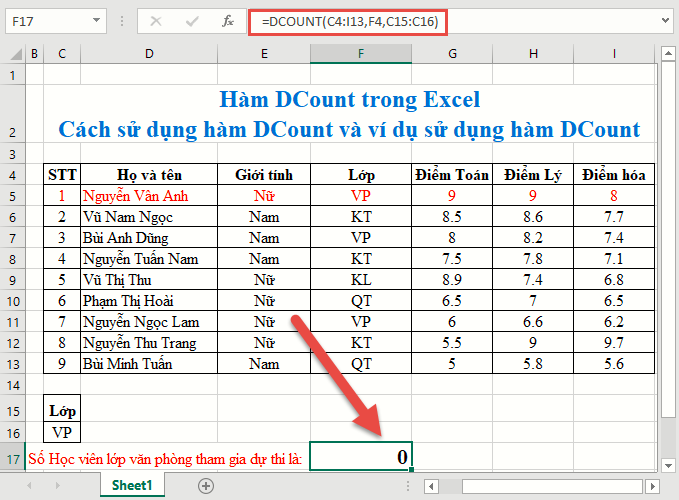
As you can see, there are 3 office students taking the exam but the result is zero. Because the Dcount function only counts with numeric data, the class condition = VP is a character type so the function returns a value of 0. So With this condition you use another function to count.
So through the first requirement you need to know that the Dcount function only uses counting with data of numeric data types.
2. Count the total number of students with math scores greater than or equal to 8
The data to be counted is a numeric data type in the Math score column. In the box to calculate the students with math scores greater than or equal to 8 enter the formula:
= DCOUNT (C4: I13, G4, D15: D16)
With:
- C4: I13: A data area containing data to be counted.
- G4: Name of data column to check condition.
- D15: D16: Data area contains conditions.
You should note that the field name of the conditional data area must match the field name in the source data table.
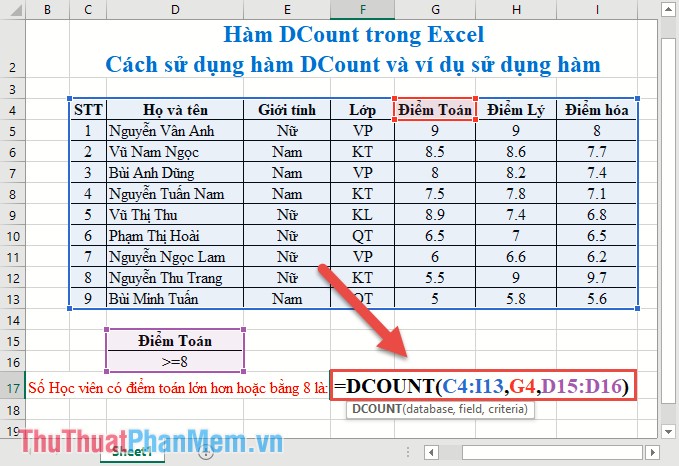
Pressing Enter results:
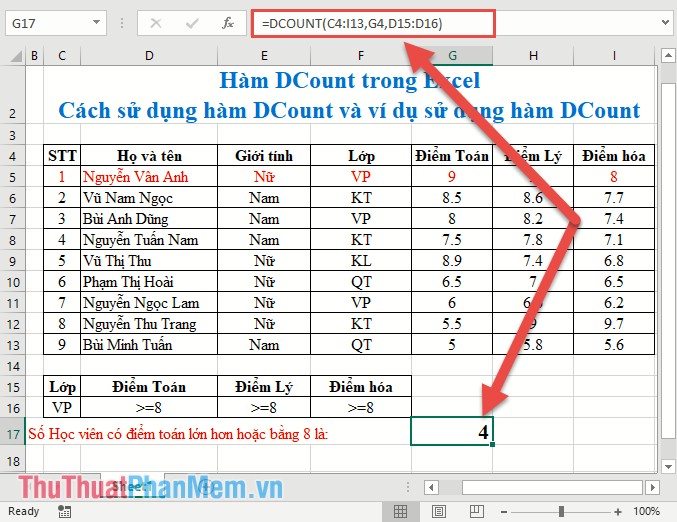
3. Count the total number of office class students with math scores greater than or equal to 8
Here, the count condition contains two conditions, but the Dcount function only uses counting numeric data types. You can do the following. To ensure that the condition is not numeric data in the range, the field name is used to check the condition of the column name containing numeric data. Create the data area containing Grade and Math Score as shown. In a cell that needs to calculate enter the formula: = DCOUNT (C4: I13, G4, C15: D16)
Thus, the condition area contains two conditions, but the column name contains the condition that you only need the column to contain numeric data:

Pressing Enter results:

4. Count the total number of students in the office class with math scores, chemistry points, and physics scores equal to or greater than 8
With this requirement, performing numerical data counting is conditional and comes with conditions that are not numeric data.
Set the condition area as shown. In the cell to calculate enter the formula: = DCOUNT (C4: I13, G4, C15: F16)

Pressing Enter results:
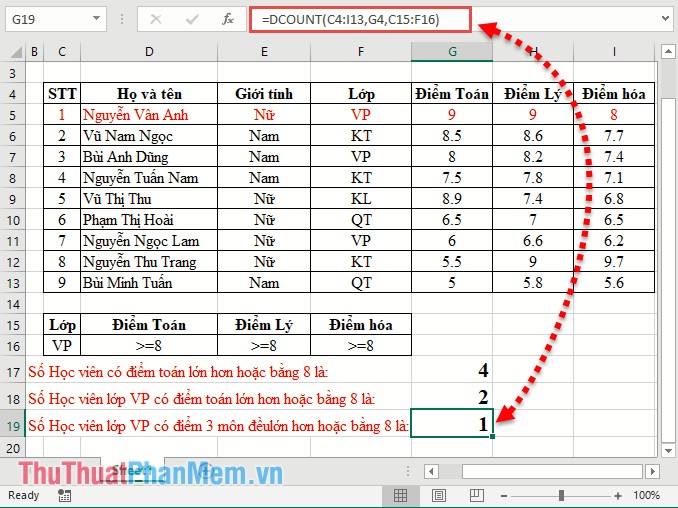
You should read it
- OR function in Excel, how to use the OR function, and examples
- INDIRECT function in Excel - How to use INDIRECT function and examples using INDIRECT function
- VLOOKUP function to use and specific examples
- IRR function in Excel - Usage and examples
- Offset function in Excel - Usage and examples
- The MID function in Excel, how to use the MID function, and examples
- How to use the SUMIF function in Excel
- DSUM function in Excel, how to use DSUM function and examples
May be interested
- The MID function in Excel, how to use the MID function, and examples
 the mid function in excel, how to use the mid function, and examples. the mid function in excel is a function of the text function group, you use the mid function if you want to cut the string in the middle of the text string when processing the string. if you do not know or do not understand the mid function, then you
the mid function in excel, how to use the mid function, and examples. the mid function in excel is a function of the text function group, you use the mid function if you want to cut the string in the middle of the text string when processing the string. if you do not know or do not understand the mid function, then you - DSUM function in Excel, how to use DSUM function and examples
 dsum function in excel, how to use dsum function and examples. the dsum function in excel is a fairly common function with a fairly simple usage. but if you do not know how to use the dsum function, you can refer to the following article to understand h
dsum function in excel, how to use dsum function and examples. the dsum function in excel is a fairly common function with a fairly simple usage. but if you do not know how to use the dsum function, you can refer to the following article to understand h - PMT function in Excel - Usage and examples
 the pmt function is one of the built-in financial functions of the excel software used to calculate the payment for a loan based on regular payments and a constant interest rate. the pmt function is not only useful for businesses, but also very practical for users if you want to calculate a loan.
the pmt function is one of the built-in financial functions of the excel software used to calculate the payment for a loan based on regular payments and a constant interest rate. the pmt function is not only useful for businesses, but also very practical for users if you want to calculate a loan. - GAMMAINV function in Excel, how to use and examples
 the gammainv function in excel helps calculate the inverse value of the cumulative gamma distribution, which is used in statistics and data analysis. this article will guide you on how to use the gammainv function with specific illustrative examples.
the gammainv function in excel helps calculate the inverse value of the cumulative gamma distribution, which is used in statistics and data analysis. this article will guide you on how to use the gammainv function with specific illustrative examples. - How to use the MAXA function in Excel, detailed examples
 the maxa function in excel helps find the largest value in a data set, including numbers, logical values, and text containing numbers. this is different from the max function, which only counts numbers. let's learn the syntax and usage of the maxa function with practical examples.
the maxa function in excel helps find the largest value in a data set, including numbers, logical values, and text containing numbers. this is different from the max function, which only counts numbers. let's learn the syntax and usage of the maxa function with practical examples. - LEFT function in Excel, how to use LEFT function and illustrative examples
 left function in excel, how to use left function and illustrative examples. left function in excel is a function of string processing function, you use left function when you need to cut the character string to the left of the text string. if you need to learn more about mid functions, be patient
left function in excel, how to use left function and illustrative examples. left function in excel is a function of string processing function, you use left function when you need to cut the character string to the left of the text string. if you need to learn more about mid functions, be patient - How to use the SUMIF function in Excel
 the sumif function in excel is a function used to compute values in a specified range. the sumif function can be used for summing cells based on the date, data and text that are connected to the specified area.
the sumif function in excel is a function used to compute values in a specified range. the sumif function can be used for summing cells based on the date, data and text that are connected to the specified area. - Choose function in Excel, how to use the Choose function and illustrative examples
 choose function in excel, how to use the choose function and illustrative examples. you are looking for ways to use the choose function in excel so you can use the choose function quickly. so, please refer to the following article to know the choose function syntax, for example how
choose function in excel, how to use the choose function and illustrative examples. you are looking for ways to use the choose function in excel so you can use the choose function quickly. so, please refer to the following article to know the choose function syntax, for example how - The function takes whole parts in Excel - Specific examples
 the function takes whole parts in excel - specific examples. excel has 2 functions that involve taking integer parts: quotient, int. there are many people who have a confusion between these two functions, only when you understand the nature of each one can you use them most accurately.
the function takes whole parts in excel - specific examples. excel has 2 functions that involve taking integer parts: quotient, int. there are many people who have a confusion between these two functions, only when you understand the nature of each one can you use them most accurately. - Random function in Excel (RAND function), how to use the Random function and examples
 random function in excel (rand function), how to use the random function and examples. you need to get a random value in a range of values. to avoid duplicate values and objectivity, you should use the rand () function. the article below gi
random function in excel (rand function), how to use the random function and examples. you need to get a random value in a range of values. to avoid duplicate values and objectivity, you should use the rand () function. the article below gi










 Functions rounded up, how to round up in Excel
Functions rounded up, how to round up in Excel INDIRECT function in Excel - How to use INDIRECT function and examples using INDIRECT function
INDIRECT function in Excel - How to use INDIRECT function and examples using INDIRECT function Comparison functions in Excel - How to use comparison functions and examples using comparison functions
Comparison functions in Excel - How to use comparison functions and examples using comparison functions How to align in Word - Instructions on how to align in Word 2007, 2010, 2013, 2016
How to align in Word - Instructions on how to align in Word 2007, 2010, 2013, 2016 Delete pages in Word - Instructions on how to delete pages in Word
Delete pages in Word - Instructions on how to delete pages in Word